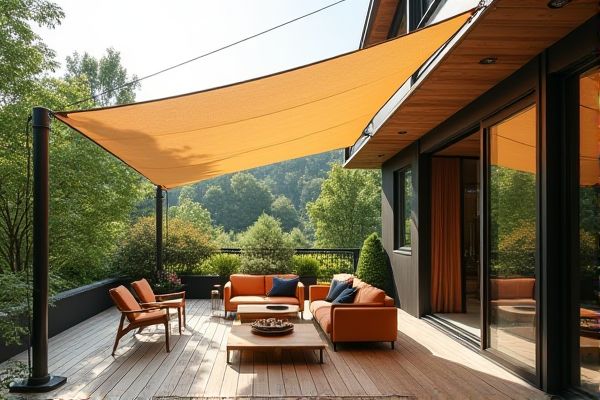
Shade sails offer a modern, flexible solution for outdoor sun protection, using tensioned fabric to cover larger areas with minimal support structures. Your choice between shade sail vs awning depends on factors like installation preferences, aesthetic appeal, and durability; explore the rest of the article to discover which option suits your needs best.
Table of Comparison
| Feature | Shade Sail | Awning |
|---|---|---|
| Material | Durable fabric (HDPE, polyester) | Canvas, acrylic, vinyl |
| Installation | Fixed tensioned structure, requires anchor points | Retractable or fixed, mounted on walls or windows |
| Sun Protection | High UV block (up to 95%) | Effective UV and rain protection |
| Design | Modern, versatile shapes (triangles, rectangles) | Traditional or motorized with various styles |
| Durability | Resistant to fading, mold, and tearing | Weather-resistant, but fabric may wear over time |
| Maintenance | Low maintenance, easy cleaning | Requires periodic cleaning and mechanical checks |
| Cost | Generally lower cost | Higher cost, especially motorized options |
| Weather Resistance | Good for sun, limited rain protection | Good sun and rain protection |
| Common Uses | Patios, playgrounds, pools | Windows, patios, storefronts |
Introduction to Shade Sails and Awnings
Shade sails and awnings provide versatile outdoor shading solutions designed to protect against sun and UV exposure. Shade sails, made from durable, weather-resistant fabric, are tensioned between anchor points to create modern, customizable areas of shade. Awnings, often retractable, are attached to building exteriors and offer adjustable coverage while enhancing architectural aesthetics and energy efficiency.
Key Differences Between Shade Sails and Awnings
Shade sails offer a flexible, modern design with tensioned fabric creating a sleek, triangular or polygonal canopy, ideal for large, irregular spaces. Awnings attach directly to a building, often retractable, providing adjustable sun protection and weather resistance with more structured frames. Your choice depends on desired aesthetics, functionality, and installation requirements, as shade sails are more versatile in shape while awnings offer convenience and durability.
Design and Aesthetic Considerations
Shade sails offer a sleek, modern aesthetic with their minimalist, geometric shapes and vibrant color options, making them ideal for contemporary outdoor spaces. Awnings, available in retractable or fixed models, provide a traditional look with fabric or metal materials that complement classic home exteriors and offer detailed patterns or stripes. Design flexibility in shade sails allows for creative installation angles and layering, while awnings excel in versatility with adjustable extensions and manual or motorized controls.
Installation Process Comparison
Shade sails feature a straightforward installation process involving securing fabric to fixed anchor points, which often requires fewer structural modifications and less time compared to awnings. Awnings typically demand more complex installation, including mounting brackets to the building facade and connecting mechanical or motorized components. The simplicity of shade sail installation provides a flexible, cost-effective solution, whereas awnings offer adjustable coverage at the expense of increased installation complexity.
Durability and Maintenance Needs
Shade sails offer superior durability due to their high-quality, UV-resistant fabrics that withstand harsh weather conditions with minimal fading or tearing. Awnings, often made from canvas or acrylic materials, may require more frequent maintenance such as cleaning and reproofing to prevent mold and mildew buildup. Your choice depends on whether you prefer the low-maintenance resilience of shade sails or the classic look and occasional upkeep of awnings.
Cost and Budget Factors
Shade sails typically offer a more budget-friendly option compared to awnings, with prices varying based on size, fabric quality, and installation complexity. Awnings generally involve higher upfront costs due to motorized or retractable features, along with potential maintenance expenses. Your choice should consider long-term durability and installation fees to ensure optimal cost-efficiency for your outdoor space.
Weather Protection and Performance
Shade sails provide flexible, breathable coverage that excels in hot, sunny conditions by allowing airflow and reducing heat buildup, while awnings offer more robust protection against rain and wind due to their sturdy frames and waterproof materials. You can rely on awnings for consistent, all-weather shelter, particularly in climates with frequent storms, whereas shade sails perform best in dry, sunny environments with moderate wind. Both options enhance outdoor comfort, but selecting the right one depends on your specific weather exposure and performance needs.
Versatility and Application Options
Shade sails offer greater versatility with their customizable shapes and sizes, making them ideal for irregular spaces and creative outdoor designs. Awnings provide more structured and retractable solutions, better suited for windows, patios, and decks where adjustable shade control is desired. Your choice depends on whether you prioritize flexible, artistic coverage or practical, adjustable protection.
Pros and Cons of Shade Sails vs Awnings
Shade sails offer versatile coverage with a sleek design that resists UV rays and improves outdoor aesthetics, but they require sturdy anchor points and may not provide full protection in heavy rain. Awnings provide reliable, adjustable shade and weather protection, usually featuring retractable mechanisms for flexibility, but they tend to be bulkier and can be more expensive to install and maintain. Choosing between shade sails and awnings depends on specific needs for durability, weather protection, installation complexity, and design preference.
Which Shade Solution Is Right for You?
Shade sails offer a modern, stylish solution with versatile shapes and easy installation, ideal for large outdoor areas requiring customizable coverage. Awnings provide adjustable, retractable shade with protection against rain and sun, perfect for patios or windows where flexibility and durability matter. Consider the environment, desired coverage area, and maintenance preferences to determine whether shade sails or awnings best suit your outdoor space needs.
 homyna.com
homyna.com